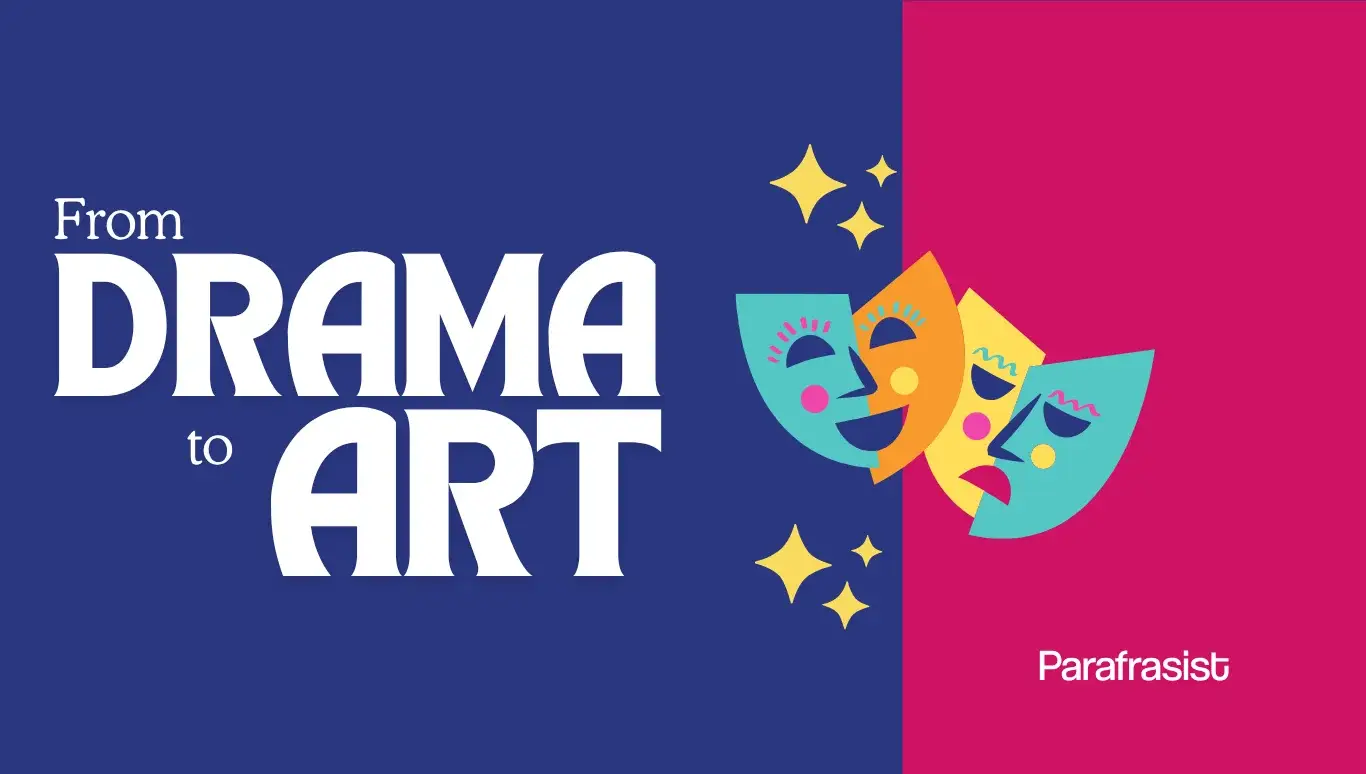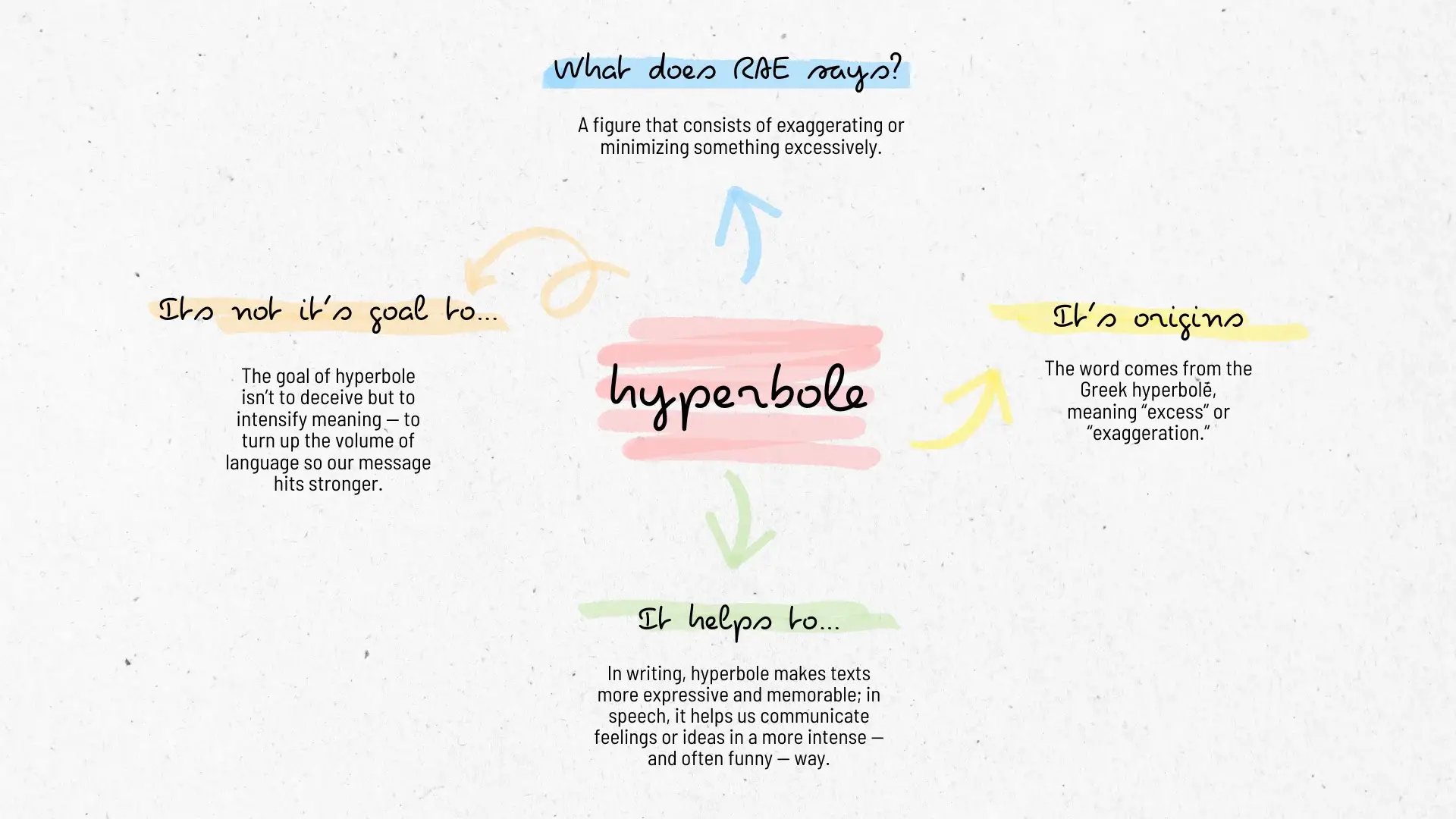What Is a Hyperbole? Meaning, Definition, and Everyday Examples
Victoria | Equipo de redacción
November 4, 2025

Have you ever said something like “I’m starving,” “I told you a million times,” or “Everyone’s the same”?
If the answer is yes (and honestly, who hasn’t?), congratulations — you’ve already used a hyperbole.
A hyperbole is a rhetorical figure we use all the time without realizing it. We turn to it whenever we want to add emotion, emphasis, or drama to what we say. In writing, hyperbole makes texts more expressive and memorable; in speech, it helps us communicate feelings or ideas in a more intense — and often funny — way. It’s also a powerful tool for irony and humor in daily life.
If you’re dying to know more about this fascinating figure of speech, you’re in the right place. We’ll go over its definition, meaning, common examples, and its uses in literature, advertising, and everyday communication.
What Is a Hyperbole? Definition and Meaning
According to the Royal Spanish Academy, a hyperbole is “a figure that consists of exaggerating or minimizing something excessively.”
In simpler terms, a hyperbole is a rhetorical or literary device that intentionally exaggerates a quality, action, or idea to highlight a specific trait or feeling.
The word comes from the Greek hyperbolḗ, meaning “excess” or “exaggeration.” In essence, hyperbole helps us stretch the limits of reality to make our words more vivid, funny, or powerful.
“I’ve been waiting for you forever.”
Of course, it hasn’t literally been forever — it just felt like a really long time.
The goal of hyperbole isn’t to deceive but to intensify meaning — to turn up the volume of language so our message hits stronger, sounds funnier, or feels more emotional.

Common Hyperbole Examples and Their Meanings
Here are some everyday hyperboles and what they really mean:
“It’s the cutest cat in the world.” → It’s a very cute cat.
“I’m dying of fear.” → I’m extremely scared.
“There’s not even room for a pin.” → It’s completely full.
“I have a million things to do.” → I have a lot to do.
“She had a smile from ear to ear.” → She was smiling broadly, really happy.
“The line was endless.” → The line was very long.
“Everybody knows Taylor Swift.” → Taylor Swift is super famous.
“You’ve told that story a thousand times.” → You’ve told it way too many times.
“I’m melting, it’s so hot.” → It’s extremely hot.
“He never stops talking.” → He talks a lot.
“I’ve done this a million times.” → I’ve done this many times.
“I’m dead tired after work.” → I’m really exhausted.
Hyperbole adds flair and personality to everyday speech — it’s what makes language colorful and engaging.
Uses of Hyperbole
Hyperbole isn’t just about being dramatic or funny — it’s one of the most flexible tools in communication. You’ll find it in literature, speeches, advertising, and even memes. Its charm lies in how it amplifies reality to grab attention or create emotion.
Hyperbole in Literature
Writers and poets have relied on hyperbole for centuries to make emotions unforgettable.
For example:
“I love you till the seas go dry and the stars fall from the sky.”
(An English-style rephrasing inspired by hyperbolic love poetry, like Pablo Neruda’s verses.)
Here, the exaggeration expresses deep, everlasting love.
Hyperbole in Advertising
In advertising, hyperbole is a classic attention-grabber. Brands use it to make their products sound bigger, better, faster, or stronger than anything else.
For instance:
“Nothing is impossible.” – Adidas
“Red Bull gives you wings.” – Red Bull
These slogans exaggerate reality on purpose — not to mislead, but to make you remember them.

Other Rhetorical or Literary Devices
While hyperbole is one of the easiest figures to recognize, it belongs to a larger family of rhetorical devices — creative language tools that make communication more expressive and artistic.
Hyperbole is an intentional exaggeration that brings life and emotion to language. It helps us express strong feelings, emphasize ideas, and capture attention — whether in poems, ads, or daily conversations.
It reminds us that exaggeration can also be an art form — one that turns simple words into something memorable and full of energy.
If you want to test your knowledge, try a quiz!
With ParafraQuiz, you can practice everything you learned about hyperbole — theory, meaning, and real-life examples. You’ll never get enough of it!
